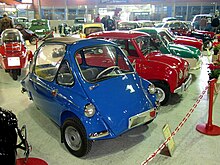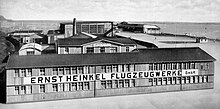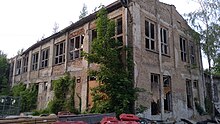Ernst Heinkel Flugzeugwerke
| Ernst Heinkel Flugzeugwerke GmbH / AG
|
|
|---|---|
| legal form | Limited Liability Company , Public Company |
| founding | December 1, 1922 (March 31, 1943: forced conversion to Ernst Heinkel AG) |
| resolution | 1964 |
| Reason for dissolution | Integration into the United Aviation Technology Works (VFW) |
| Seat | Rostock , Germany |
| management | Ernst Heinkel |
| Number of employees |
|
| Branch | Aircraft manufacturers , defense industry , engine manufacturers , automobile manufacturers |
The Heinkel GmbH (from 1943 Ernst Heinkel AG), short Heinkel was one of the largest aerospace companies in the first half of the 20th century. Ernst Heinkel Flugzeugwerke held 1,352 patents in the field of aviation and 587 industrial property rights in the engine sector. Machines and licenses were sold to Denmark , Finland , Sweden , Hungary , the Soviet Union and Asia. The company constructed civil and later especially military aircraft. It brought Rostock the final breakthrough in terms of industrialization in the first half of the 20th century. Rostock became a modern city and a high-tech location. The number of employees rose from around 1,000 in 1932, also due to the operation of further plants in Germany and in occupied Poland and Austria, over around 9,000 in mid-1939 to around 16,000 at the end of 1944.
history
Weimar Republic
Ernst Heinkel founded the Ernst Heinkel Flugzeugwerke Warnemünde on December 1st, 1922 . The first aircraft were the HE 1 and HE 2 float planes, the delivery of which, despite the conditions imposed by the victorious powers of the First World War, was carried out through cooperation with Kapitänleutnant a. D. Walter Hormel became possible, and the development of the HE 3 training aircraft, which began at the end of 1923 and was designed by chief designer Karl Schwärzler (1901–1974). In 1931, Ernst Heinkel received the notice from the Reich Commissioner responsible for his rented hangars in Warnemünde, the location was on the site of the Seaplane Test Command, a military facility. As an emergency solution, the company's headquarters were relocated to Rostocker Bleicherstraße. It was a manageable site with no expansion options, but due to its close proximity to the freight station it offered good conditions, at least under logistical aspects. At this time, Heinkel built various types of aircraft for the Reichswehr Ministry and postal aircraft.
time of the nationalsocialism
The Heinkel-Werke had already become Mecklenburg's largest industrial company in 1932. At the suggestion of the head of the still secret Air Force Administration Office, Albert Kesselring, after a visit to Heinkel in Bleicherstrasse, planning began in 1933 for a new plant near Rostock for around 3,000 workers. In return, the Air Force Administration Office guaranteed high purchase prices for the aircraft. The small location in Bleicherstraße did not allow mass production of armaments, so planning began for a large development and production site on a 300-hectare property belonging to the state domain in Rostock-Marienehe . From 1934, production was also carried out in the halls of the Norddraht company taken over by Heinkel in Rostock Werftstrasse.
In the spring of 1934 the new building could be started on the site in Rostock-Marienehe. The shell for the first construction phase was finished in December 1934. Production in Marienehe started in 1935. The new plant became the most modern aircraft plant in Europe and quickly became the main plant of Heinkelwerke. It had its own works airfield with five paved runways . The main line, which ran in a west-east direction, had a length of 1,500 m. In the plant there were previously unknown social facilities for the employees in Rostock, such as cheap and good communal meals from the canteen and a health center , where, for example, preventive health protection (e.g. with Kneipp cures ) was ensured. In addition, there was a generous apprenticeship training and professional development in the company, sports facilities and cultural support for the family. The construction of subsidized apartments for the employees caused entire districts ( old Reutershagen, composers quarter ) to be rebuilt. Before the war began, the company usually paid above-average wages for comparable industries. Of a total of more than 55,000 employees, around 17,000 workers (including forced laborers and prisoners of war ) were employed in 1945 .
From 1935, the Heinkel works also worked for the Heereswaffenamt , for which Wernher von Braun advanced the development of a rocket propulsion system with liquid fuel. The result was the Heinkel He 176 , equipped with a rocket engine from the Kiel company Walter , whose first flight took place on June 20, 1939 on the grounds of the Peenemünde-West air force test site .
In Rostock-Marienehe, pilot Erich Warsitz carried out the world's first jet-powered flight with the Heinkel He 178 on August 27, 1939 . The machine was driven by a 378 kg Heinkel HeS 3b jet turbine, which had been developed by Hans Pabst von Ohain .
Ernst Heinkel was the type of a solitary inventor-entrepreneur and pursued a corporate strategy of constantly acquiring new plants and areas of activity. The "Heinkel-Tempo" adopted here, however , was viewed by key representatives of the armaments industry as a poorly coordinated and barely concentrated development policy, the constant exceeding of deadlines during production could no longer be disguised with improvisations. Heinkel came more and more under state influence and finally had to submit to a financial consolidation prescribed by the armaments authority, which was reflected in the establishment of "Ernst Heinkel AG" (EHAG) in 1943. With the construction of the AG, Heinkel's direct influence on his operations was stopped for the time being. Although he kept two thirds of the company's capital, he had to be content with the post of chairman of the supervisory board.
In 1936 work began on setting up a new Heinkel branch in Oranienburg . Forced laborers and prisoners from the Sachsenhausen concentration camp were used on a large scale in the city of Oranienburg . After the USA entered the war , the air strikes were now carried out by the US bombers during the day, too , with targeted industrial companies in their sights.In the beginning, the shutdown of production facilities for aircraft was an important goal of the US bomber squadrons in order to achieve air superiority to the British, who until then had mainly bombed large cities during the night. The anti-aircraft guns and fighter planes of the time were much less effective at night or had to be specially designed as night fighters . On April 1, 1943, not only the Ernst Heinkel AG was established , but several small external plants were also created, so the new plants were initially mostly unknown to the Allies and due to their high number and small size, the loss of such a plant was not comparable with great works like in Oranienburg.
One of the concentration camp's largest satellite camps was set up for the Heinkel works; up to 8,000 concentration camp prisoners had to work at the plant. At the Oranienburg site, there are still the White City site (architect Herbert Rimpl ), parts of the company airport and the Leegebruch site , which was built specifically for the workers of the aircraft factory. In addition to the large satellite camps, there were also several smaller satellite camps spread across the entire German Reich. In Krakow am See , for example, such a small factory was built in the grain halls of the small Mecklenburg town for the construction of aircraft parts for 150 to 200 workers, for which a satellite camp of the Ravensbrück concentration camp , the largest concentration camp for women in the German Reich, was built for the slave laborers.
In Rostock, Heinkel had production facilities in Marienehe, on Bleicherstraße, Werftstraße and on Patriotischer Weg. There was also production in Lübz , Rövershagen , Ribnitz and Barth . There were also plants in Berlin-Reinickendorf and Oranienburg ( Heinkel-Werke Oranienburg ), at Vienna-Schwechat Airport (from 1942), in Jenbach / Tyrol (from 1939), in the Harz Mountains , in Krakow and near Paris .
| Organization for the period from December 1, 1922 to March 31, 1943 | |||
|
Ernst Heinkel Flugzeugwerke GmbH founded on December 1st, 1922 Rostock, Warnemünde |
|||
|
Heinkel-Werke GmbH founded on May 1, 1936 in Berlin , Oranienburg , Germendorf |
Hirth Motoren GmbH took over Stuttgart-Zuffenhausen in April 1941 |
Jenbacher Berg- und Hüttenwerke founded in 1939 Jenbach |
United Ostwerke GmbH took over on October 1, 1939 Krakow , Mielec |
| Organization for the period April 1, 1943 to May 1945 | |||||||
|
Ernst Heinkel AG founded on April 1st, 1943 Rostock |
|||||||
|
Rostock plant Rostock-Marienehe |
Oranienburg Berlin, Oranienburg, Germendorf plant |
Vienna plant Vienna-Heidfeld |
Hirth Motoren Stuttgart-Zuffenhausen plant |
Waltersdorf plant in Waltersdorf |
Jenbach plant Jenbach |
United East Works Krakow, Mielec |
Repair shop Copenhagen-Kastrup |
| Rostock, Bleicherstraße Rostock, Werftstraße Rostock, Patriotic Way Pütnitz Oelsnitz / Vogtland Adorf Barth Krakow am See Lübz Güstrow Rövershagen Staßfurt |
Castle Oels Como |
Twelve faxing Schwechat Mödling Vienna-Hilden Vienna- Floridsdorf Vienna-Groß Jedlersdorf Langenzersdorf |
Backnang Kochendorf Kolbermoor |
Berlin-Grünau Wunchendorf |
Mielec Budzyń Wieliczka Bad Gandersheim |
Konstruktionsbüro Paris , design office Amsterdam | |
From 1945



When Rostock was occupied by Soviet troops on May 1, 1945, aircraft construction came to a standstill. First of all, everything that was somehow usable was dismantled in the partly bombed factories and brought to the Soviet Union as reparations . The dismantling work lasted at least until 1948. The remains of the halls and buildings were blown up and leveled. From 1950 the Rostock fish combine was built on the now cleared area . An important chapter of German and international technology and aircraft history was over.
Soon after the Second World War , Heinkel AG was engaged in construction services for third parties at its new headquarters in Stuttgart (e.g. the development of a three-cylinder two-stroke engine for the Swedish Saab 93 ) and then began manufacturing engines itself. For example, the water-cooled traditional two-cylinder -Zweitaktmotoren the Maico - small car and the pace -Lieferwagen Heinkel. This was followed by mopeds (“Heinkel-Perle”), scooter mobiles (“ Heinkel Cabin ”) and motor scooters, the most famous of which is the “ Tourist ” motor scooter with a 175 cm³ four-stroke engine . This was sold in large numbers until the mid-1960s, among other things it was also used as a mail delivery vehicle or as a police vehicle. In 2015, around 7,000 of these scooters were registered in Germany, which speaks for their quality and durability.
About 17,000 of the "Heinkel cabs" were built in Germany, Argentina, Ireland (at Dundalk Engineering Company ) and England (there from Trojan Limited as "Trojan" until 1965). Heinkel engine production continued until the late 1960s.
On the site of the former Saarpfalz airframe in Speyer , aircraft development under the name Ernst Heinkel Fahrzeugbau was resumed from 1958 . Heinkel also manufactured the “Heinkel Cab” there until the systems were sold to Ireland.
The Heinkel vehicle merged in 2000 with company Heinkel Medical Systems to Modulbau GmbH Heinkel in Blaubeuren , which today space modules / Container Buildings manufactures.
From 1959 to 1965, Heinkel participated in the Entwicklungsring Süd GmbH (EWR), a joint venture with Messerschmitt and Bölkow to develop the vertical take-off vehicle EWR VJ 101 .
In 1964 the company merged with Weserflug and Focke-Wulf in the United Flight Technical Works (VFW). While VFW for its part was absorbed by EADS , the Speyer plant operated under the name PFW Aerospace AG - Pfalz Flugzeugwerke until 2011, when Airbus again became the majority owner.
Traces of the past in Rostock
In Rostock- Marienehe , the training workshop of the Heinkel aircraft works and some ancillary buildings have been preserved on the site west of the railway line. The buildings were later used for fish processing by the Rostock fish combine. Today the building of the former training workshop houses the “Moya Culture Stage”, a popular event location.
The only surviving former workshop in Marienehe was made unusable as a production site by order of the Soviet occupiers and converted into a sports hall . The conversion saved them from demolition.
Immediately north of Lübecker Straße in Rostock, in the former Werftstraße industrial area, the most famous relic of the Rostock Heinkel works stood until February 2018: the Heinkel Wall. The brick wall extended over a length of about 85 meters and was up to 9½ m high, the original height was 11 m. It consisted of 24 masonry pillars and 21 mostly 3½ m wide wall fields. It was built in 1936 as a display wall to visually upgrade the street front of existing workshops and was structurally cleared in 1995 when the halls behind it were demolished. The former Neptun shipyard used the halls until 1990 . The wall itself stood since 1994 under monument protection . Despite resistance, it was demolished in 2018. In place of the wall, steles are intended to remind of the ambivalent past of the Werftdreieck site.
All production facilities at the Bleicherstraße location were also dismantled after 1945. The forwarding department of VEB Kraftverkehr Ostseetrans moved here from 1949. The site was partially redesigned, some production halls were demolished and a garage complex was built for this. The site has been empty since 1990 and the buildings are in ruins.
developments
- On- board catapults , through which on-board aircraft ( HE 12 ; HE 58 ) of express steamers of the Post with advance flights on the American route save more than 24 hours (start of testing 1927) - see also catapult ship
- He 70 (1932): at that time the fastest airliner in the world and already manufactured in a modern shell construction, and for the first time in Germany with retractable landing gear
- He 111 (1934): built by order of Lufthansa as a fast airliner, from 1937 standard bomber of the Luftwaffe
- He 100 (1938):Workspilot Hans Dieterle set the absolute world speed record for the first time in Germany with 746.4 km / h on March 30, 1939
- He 176 (1939): first airplane in the world with an adjustable rocket engine
- Development of the first turbojet engine (He S 3) under the direction of Hans-Joachim Pabst von Ohain from 1933 (with Heinkel since 1936)
- He 178 : first airplane in the world with a turbine jet engine (first flight August 27, 1939)
- Development of the ejection seat (1939)
- Patent on blast riveting in aircraft and steel construction
- He 280 : intended as a fighter aircraft, flown in 1941, prototypes
- He 219 : the first European aircraft with a nose wheel landing gear and an ejector seat fitted as standard
- HeS 011 : at the end of the war the most powerful turbo engine in the world, prototypes

Automotive engineering
In 1956, Heinkel presented a small car in the shape of a coupé with a front door, which at first glance resembled the BMW Isetta . However, the vehicle was lighter and had more space inside. From the first model 150 with three wheels and an engine with a displacement of 175 cm³ , around 6400 vehicles were built. From the following models 153 (three-wheeler) and 154 (four-wheeler), which had a larger engine with 200 cm³ displacement, around 5500 vehicles were built.
See also
literature
- Ernst Heinkel: Stormy Life . Ed .: Jürgen Thorwald. European Book Club, Stuttgart / Zurich / Salzburg 1953.
- Volker Koos: Ernst Heinkel Flugzeugwerke 1922–1932 . Heel, Königswinter 2006, ISBN 3-89880-502-6 ( [1] - review).
- Volker Koos: Ernst Heinkel Flugzeugwerke 1933–1945 . Heel, Königswinter 2003, ISBN 3-89880-217-5 .
- Till Bastian : high tech under the swastika . From the atomic bomb to space travel. Militzke, Leipzig 2005, ISBN 3-86189-740-7 , p. 97-125 and 222 .
- Norbert Rohde : Historical military objects of the Oberhavel region. Volume 1: The Heinkel aircraft factory in Oranienburg . Velten / Leegebruch 2006, ISBN 3-9811401-0-9 .
Web links
- Ernst Heinkel Flugzeugwerke AG (Aviation Museum)
- Official website information “Newspaper Airplanes” (HD 39 and HD 40) from EADS
- Information on satellite camps at the Brandenburg Memorials Foundation
- On the person of Ernst Heinkel in the NS (PDF; 26 kB) Critique of an exhibition
- Heinkel cabin
- Ernst Heinkel and the dream of flying on NDR.de
- Newspaper article on Ernst Heinkel Flugzeugwerke in the press kit of the 20th century of the ZBW - Leibniz Information Center for Economics .
Individual evidence
- ↑ Of winners and losers - Bäumer's fall and Heinkel's rise. In: FliegerRevue April 2010, pp. 56–59.
- ^ A b Norbert Rohde: Historical military objects of the Oberhavel region. P. 15.
- ↑ Thomas Niebuhr, Andreas Meyer: Heinkel-Mauer: demolition right at the beginning of the year. In: ostsee-zeitung.de. December 7, 2017, accessed July 26, 2019 .
- ↑ Claudia Labude-Gericke: Rostock Monument: Heinkel Wall: Wiro starts demolition. January 8, 2018, accessed July 26, 2019 .
- ↑ Bernd Froehlich: The "Heinkel wall" in Rostock. April 2016, accessed June 9, 2020 .







